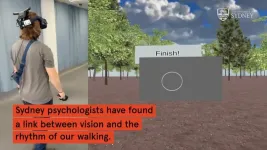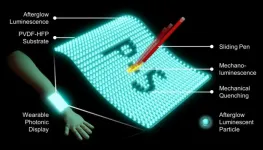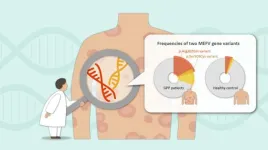(Press-News.org) For the first time, neuroscientists have established a link between shifts in our visual perception and the cadence of our steps while walking.
The research, published in Nature Communications, shows that the brain processes vision in a rhythmic manner, rising and falling in sensitivity in a cycle that corresponds to the rhythm of our steps. When swinging from one step to the next, human perception is good and reactions fast.
During footfall, however, our vision is not as sharp and reactions are slowed.
Lead author Dr Matthew Davidson from the School of Psychology at the University of Sydney said: “This work reveals a previously unknown relationship between perception and movement. It bridges a gap between experimental psychology and our natural, everyday behaviour.”
The study also confirms our understanding of the visual brain sensing the environment in a strobe-like way; our perception takes regular samples of the world before stitching them together to create our seamless experience.
However, the new finding that reveals shifts in our visual perception has important implications for understanding human behaviour, how we interact with our environment and make decisions.
The work was conducted by Dr Matthew Davidson with colleagues Professor David Alais and Professor Frans Verstraten in the School of Psychology, University of Sydney.
Dr Davidson said: “We are consciously aware of a seamless stream of vision but this is deceptive. I use the analogy of a duck swimming on a pond. Beneath the smooth motion on the surface there is a lot cycling activity beneath.”
This study extends earlier work from the same lab showing that perception of vision and sound is cyclic, with our brain taking around eight samples per second.
Professor Alais said: “The critical new finding in this study is that these oscillations in the brain’s sampling of the world slow down when walking to match the step cycle.
“Humans take about two steps per second when walking and generally keep to a consistent rhythm. The reported oscillations in visual sensitivity also occur at about two cycles per second and are locked to the step cycle. In some participants these rhythmic oscillations occur at four cycles per second but these were also locked to the step cycle.”
This work is the first time that visual perception has been finely and continuously sampled during walking. Without virtual reality headsets and motion tracking it would not be possible.
Dr Davidson said: “Thanks to VR technology we have discovered that our vision moves through a good and a bad phase on every step.”
It is unclear why our brain’s perceptual processes are so closely linked to walking.
Professor Alais said: “One possible explanation is that vision becomes secondary to motor control while your foot is grounded and the next step is planned. Once you are in the swing phase between footfalls, the brain switches back to prioritising perceptual sampling of the world, creating an ongoing perceptual rhythm that harmonises with your step rate.”
The findings open questions that the research team will pursue in further studies. For example, does perception of sound and touch also modulate as we walk? And what about neural activity?
The research team plans to follow up these questions to further understand the implications.
Dr Davidson said: “An obvious question is whether these oscillations in perception are more pronounced in the elderly given difficulties with balance and coordination as we age.
“It also raises the exciting possibility that we could develop cheap and easy diagnostic tests using VR headsets, or use this information to develop tests for early onset of neuro-muscular disorders or some psychiatric illnesses, which can manifest in abnormal gaits.”
He said it could also be applied to further research in sports science to see if the findings could be applied to optimise decision-making and reaction times in athletes.
Underlying all this research remains a persistent mystery. If the world is sampled by our brains rhythmic pulses, why is our conscious perception so seamlessly smooth?
Professor Verstraten said: “This was once a question for philosophers, but with access to technology neuroscientists have been able to shed light on how the gaps get filled in. The current view is that the brain is a predictive machine that actively constructs perception and predicts what ought to be there and fills in the blanks. But clearly, we need more research to deepen our understanding.”
Methods
Researchers tracked the walking of 45 subjects walking back and forth along a 10-metre path in a virtual environment. During each walk (lasting about 9 seconds), subjects were required to respond to between zero and eight random visual stimuli. The same stimuli were also presented in stationary trials. Eye and head movement was tracked along with gait and walking information.
Of the 45 subjects, insufficient data was collected for seven subjects. In the datasets for 38 subjects, reduced perception at footfall was recorded 83 percent of the time.
The behavioural data generated in this study have been deposited in a public database under accession code https://osf.io/8djtq/
DOWNLOAD video showing the simulation environment at this link.
INTERVIEWS
Dr Matthew Davidson | matthew.davidson@sydney.edu.au
Professor David Alais | david.alais@sydney.edu.au
MEDIA ENQUIRIES
Marcus Strom | marcus.strom@sydney.edu.au | +61 474 269 459
DECLARATION
The authors declare no competing interests. Research was in part funded by the Australian Research Council.
END
Foot-eye coordination: how our vision changes in rhythm with our walking
Neuroscience research explores how we see the world, step by step
2024-03-07
ELSE PRESS RELEASES FROM THIS DATE:
Researchers discover new cancer-fighting role for neutrophils
2024-03-07
In a study published in Cell on March 5, Prof. ZHANG Xiaoming at the Shanghai Institute of Immunity and Infection (SIII) of the Chinese Academy of Sciences and Profs. GAO Qiang, FAN Jia and YANG Li at Fudan University have uncovered an unexpected level of complexity hidden within neutrophils, which were previously thought to be a relatively uniform population of short-lived immune cells.
Using cutting-edge single-cell RNA sequencing technology, the researchers analyzed individual neutrophils across a remarkable 17 different cancer types from 143 patients. They revealed that neutrophils can adopt at least ...
Personality and mental health factors linked to vaping uptake
2024-03-07
University of Otago researchers have discovered three psychological factors that predict if a non-smoker will start vaping.
The study, published in the journal Drug and Alcohol Review, investigates how psychological traits related to personality and mental health predict the likelihood of vaping uptake over time in non-smoking adults.
Researchers, led by Professor Tamlin Conner of the Department of Psychology and Andre Mason of the Department of Psychological Medicine, analysed longitudinal data of more than 36,000 New Zealand adults from the New Zealand Attitudes and Values Study (NZAVS).
They found people who ...
Powerless mechanoluminescent touchscreen underwater
2024-03-07
Optical properties of afterglow luminescent particles (ALPs) in mechanoluminescence (ML) and mechanical quenching (MQ) have attracted great attention for diverse technological applications. Recently, a team of researchers from Pohang University of Science and Technology (POSTECH) has garnered attention by developing an optical display technology with ALPs enabling the writing and erasure of messages underwater.
The team, comprised of Professor Sei Kwang Hahn and PhD candidate Seong-Jong Kim from the Department of Materials Science and Engineering at the POSTECH, uncovered a distinctive optical phenomenon in ALPs. Subsequently, they successfully created ...
Missing disease-related gene identified in generalized pustular psoriasis
2024-03-07
A team from Nagoya University in Japan has identified previously unidentified gene variants that are associated with the development of generalized pustular psoriasis (GPP). The team’s findings, published in the Journal of the American Academy of Dermatology, offer hope for improving diagnosis and therapy.
GPP is rare, but its effects are often serious. People with GPP can experience recurrent flares of the disease, which include multiple erythematous lesions and sterile pustules over the whole body, often accompanied by fever ...
Schisanhenol: A potential drug for the treatment of cytokine storm
2024-03-07
Background and objectives
Cytokine storm (CS) is an acute systemic inflammatory response with limited effective interventions up to now. The treatment experience of the COVID-19 pandemic suggests great potential in the intervention of CS by herbal medicine. This study aimed to investigate whether Schisanhenol (SSH), an active component of the Chinese herbal medicine Schisandra chinensis, has the potential to interfere with CS.
Methods
The effect of SSH on nuclear factor-kappa B (NF-κB) signaling pathway activity ...
Revealing a hidden threat: Researchers show viral infections pose early heart risks
2024-03-07
In a potentially game-changing development, scientists with the Fralin Biomedical Research Institute at VTC have revealed a new understanding of sometimes fatal viral infections that affect the heart.
Traditionally, the focus has been on heart inflammation known as myocarditis, which is often triggered by the body’s immune response to a viral infection.
However, a new study led by James Smyth, associate professor at the Fralin Biomedical Research Institute, sheds new light on this notion, revealing that the virus itself creates potentially dangerous conditions in the heart ...
Study reveals unexpected literacy in autistic people who cannot speak
2024-03-06
About one-third of autistic people are unable to communicate using speech, and most are never provided an effective alternative. However, a new study from scientists at the University of Virginia suggests that many of these individuals are literate, raising the possibility that they could learn to express themselves through writing.
The study published in the journal Autism, reports that five times more nonspeaking autistic teenagers and adults demonstrated knowledge of written language conventions than would be expected from previous estimates of their abilities. The finding has important implications for the millions of autistic ...
The sweet stuff: How insects tell sugars apart
2024-03-06
New Haven, Conn. — Whereas humans have one receptor on their tongues that can detect all sorts of sweet things, from real sugar to artificial sweeteners like aspartame, insects have many receptors that each detect specific types of sugars. Yale researchers have now uncovered one way insect receptors are able to be so selective, an insight they say will help us understand how animals decipher the chemical world and how we might mimic that ability in the future.
They reported their findings in a study published March 6 in Nature.
Sugar is important to animals ...
What are Hubble and Webb observing right now? NASA tool has the answer
2024-03-06
It’s not hard to find out what NASA’s Hubble and James Webb space telescopes have observed in the past. Barely a week goes by without news of a cosmic discovery made possible using images, spectra, and other data captured by NASA’s prolific astronomical observatories.
But what are Hubble and Webb looking at right this minute? A shadowy pillar harboring nascent stars? A pair of colliding galaxies? The atmosphere of a distant planet? Galactic light, stretched and distorted on a 13-billion-year journey across ...
Medical malpractice incidents are more severe during daylight saving time
2024-03-06
DARIEN, IL – Medical malpractice incidents are more severe during the months of the year when daylight saving time is observed in the U.S., according to a new study that examined three decades of malpractice claims.
Results show that both medical malpractice incident severity and payment decisions were higher during the months of daylight saving time compared with the months of standard time, after controlling for whether states observe daylight saving time. Payment decisions also were higher, but medical incidents were not more severe, during the one week following the spring transition to daylight saving time.
“The spring daylight saving shift ...
LAST 30 PRESS RELEASES:
Numbers in our sights affect how we perceive space
SIMJ announces global collaborative book project in commemoration of its 75th anniversary
Air pollution exposure and birth weight
Obstructive sleep apnea risk and mental health conditions among older adults
How talking slows eye movements behind the wheel
The Ceramic Society of Japan’s Oxoate Ceramics Research Association launches new international book project
Heart-brain connection: international study reveals the role of the vagus nerve in keeping the heart young
Researchers identify Rb1 as a predictive biomarker for a new therapeutic strategy in some breast cancers
Survey reveals ethical gaps slowing AI adoption in pediatric surgery
Stimulant ADHD medications work differently than thought
AI overestimates how smart people are, according to HSE economists
HSE researchers create genome-wide map of quadruplexes
Scientists boost cell "powerhouses" to burn more calories
Automatic label checking: The missing step in making reliable medical AI
Low daily alcohol intake linked to 50% heightened mouth cancer risk in India
American Meteorological Society announces Rick Spinrad as 2026 President-Elect
Biomass-based carbon capture spotlighted in newly released global climate webinar recording
Illuminating invisible nano pollutants: advanced bioimaging tracks the full journey of emerging nanoscale contaminants in living systems
How does age affect recovery from spinal cord injury?
Novel AI tool offers prognosis for patients with head and neck cancer
Fathers’ microplastic exposure tied to their children’s metabolic problems
Research validates laboratory model for studying high-grade serous ovarian cancer
SIR 2026 delivers transformative breakthroughs in minimally invasive medicine to improve patient care
Stem Cell Reports most downloaded papers of 2025 highlight the breadth and impact of stem cell research
Oxford-led study estimates NHS spends around 3% of its primary and secondary care budget on the health impacts of heat and cold in England
A researcher’s long quest leads to a smart composite breakthrough
Urban wild bees act as “microbial sensors” of city health.
New study finds where you live affects recovery after a hip fracture
Forecasting the impact of fully automated vehicle adoption on US road traffic injuries
Alcohol-related hospitalizations from 2016 to 2022
[Press-News.org] Foot-eye coordination: how our vision changes in rhythm with our walkingNeuroscience research explores how we see the world, step by step








